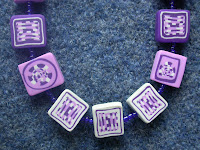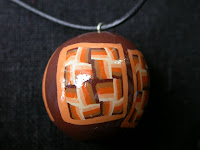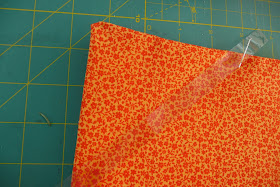 |
| Create a Base for the Tree |
1) Drill a hole in either a block of wood or stacked pieces of scrap lumber. In the example above, the branch had to be offset so that it would balance properly and not tip over.
2) Apply wood glue to the hole and insert the branch.
3) Paint the branch and base a color of your choice.
4) Cut a piece of felt and glue it to the bottom of the base. |
| Starting to Make the Heart |
1) Cut two equal sized hearts out of felt fabric.
2) Write a phrase on the felt with puff paint.
3) Let dry completely.
 |
| Stitching the Heart |
1) Use a blanket stitch with 6 ply embroidery floss.
2) Start ½ way up one side of the heart shape.
 |
| Where to Stop Stitching |
1) A space needs to be left open so that the heart can be stuffed with polyfill fiber.
2) Stop stitching within at least 1 ¼” from the starting point.
 |
| Stuffing the Heart |
 |
| Closing the Heart |
1) Hold edges of heart together with fingers.
2) Continue blanket stitch to starting point.
3) Make a small ending stitch on the edge of the heart.
4) Insert the needle between the felt layers and push it through the inside of the heart.
5) Emerge at the needle’s length
 |
| Finishing the Stitching |
1) Pull the thread slightly taut.
2) Clip the thread close to the heart
3) When the thread is clipped the tautness will relaase and the thread will be hidden inside the heart.
 |
| Embellishing with Glitter Glue |
1) Choose glitter glue colors to compliment the colors of the hearts.
 |
| Applying Glitter Glue |
1) Squeeze glue liberally around the entire edge of the heart.
2) Let dry completely.
 |
| Embellishing the Heart further |
1) Apply dots of gold or silver to the front center of the heart.
2) Let dry completely
 |
| Making the Hanging Element |
1) Measure and cut approximately 4 lengths of 1 ½ yards of ¼” ribbon.
2) Measure up approximately 10” and make a loop.
3) Insert crochet hook.
4) Chain stitch 17 stitches
5) Pull the last stitch through the ending loop and tighten
6) Bend in half.
7) Iron crocheted loop flat.
 |
| Mounting Hearts on Crocheted Ribbon Hangers |
1) Stitch or hot glue the crocheted loops to the back side of each heart.
2) If glued, apply finger pressure to set the loops firmly into the glue.
3) Be careful not to touch the glue. It is hot.
 |
| Personalizing the Heart |
1) Cut a 3” wide length of white fabric.
2) Fold the length of fabric in half.
3) Stitch a ¼” seam the length of the fabric.
4) Turn the fabric right side out.
5) Free motion stitch the recipients’ names onto the fabric.
6) Cut apart with pinking sheers.
7) Lift the ribbons away from the heart.
8) Hand stitch the name along three sides of the tag to the back of the heart.
9) Leave the top open.
10) Cut a small red, felt heart and insert it into the top of the name tag.
Some Additional Heart Examples
 |
| Examples of Completed Hearts |
 |
| Hanging the Hearts |
- Instead of using puff paint to write a phrase on the front of each heart, consider embroidering letters with contrasting embroidery floss.
- Instead of using glitter glue to embellish the edges, consider using decorative beads.
- Note that faux crystal fobs were hung on metallic thread in the example provided here. That added additional movement and a shimmering quality.





.jpg)











+bottom.jpg)





































